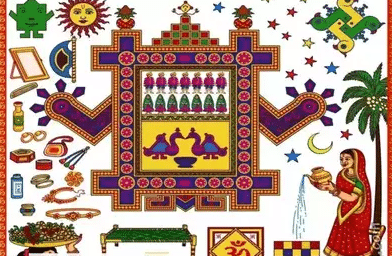
Hindu Rituals
Ahoi Ashtami Vrat: A Sacred Fast for the Well-Being of Children
Ahoi Ashtami Vrat is a significant fast observed by mothers for the health, protection, and long life of their children. In Hindu traditions, it is believed that the divine energy (Shakti) invoked during this fast blesses children with good health and longevity. This fast, which falls on the eighth day (Ashtami) of the Krishna Paksha (waning phase of the moon) in the month of Kartika, follows the popular Karva Chauth fast, and is also known as Ahoi Aathe (referring to the eighth day, or Ashtami).
Spiritual Significance
On this day, mothers seek the blessings of Ahoi Mata (a form of the Divine Mother) and Lord Ganesha, the remover of obstacles. It is believed that by observing this fast with dedication and devotion, divine intervention can aid those who face delays in childbirth or are dealing with concerns related to the health and well-being of their children. In essence, the fast is a sacred act of surrender, where mothers pray for divine grace to protect their children and ward off any negative influences.
Rituals and Worship
The day begins with the worship of Lord Ganesha to eliminate any hurdles in the observance of the fast. Then, Ahoi Mata is worshiped in the evening. This can be done at home or in the community temple. In the evening, mothers hold a handful of rice or wheat grains while listening to or narrating the Ahoi Mata Katha (sacred story). This story emphasizes the power of a mother’s love and devotion, which can alter destiny through sincere prayer.
Once the story is recited, a sweet offering known as Halwa Prasad is prepared and offered to the goddess. It is first offered to any elder women in the household—such as a mother-in-law—since their blessings hold immense spiritual value. Elders are traditionally given small tokens like money or clothes, a gesture symbolizing respect and reverence for their wisdom and guidance.
Special Tradition of Ahoi Ashtami
On this day, children in the house also partake in a playful ritual. They knock on the door and ask for “Ahoi,” symbolizing their request for divine blessings. This is a joyful tradition, believed to bring good fortune to the family. Afterward, they are invited inside, and the Halwa Puri (a sacred meal of sweet halwa and deep-fried bread) is served to them with love. The act of feeding children is a symbolic representation of nourishing them with blessings and divine energy.
The Significance of Pearls and Kalawa
A unique tradition associated with Ahoi Ashtami involves using silver pearls and the Kalawa (a sacred red thread). On this day, pairs of silver pearls are strung together along with an image of Syai Mata (another form of the goddess) and tied to the Kalash (sacred water pot). Some mothers choose to wear this around their neck for part of the day as a symbol of protection. This tradition signifies the bond between mother and child, blessed by the divine.
The Kalawa, with the pearls, is renewed each year. If a mother has two sons, two pearls are added to the thread after their marriage, signifying growth in the family. In some regions, mothers also prepare another garland, threading dry fruits, makhana (puffed lotus seeds), and candy, which is later distributed to children as prasad. This is eaten with joy and considered a divine blessing.
The Puja Timing for Ahoi Ashtami Vrat in 2024
This year, the Ahoi Ashtami Vrat will be observed on Thursday, October 24. The Ashtami Puja Muhurat (the most auspicious time for worship) begins at 5:42 PM. The stars, symbolic of the cosmic order, are visible at around 6:00 PM, and it is during this time that the fast is traditionally concluded by offering water, or Arghya, to the stars. This act represents the connection between the individual and the larger cosmos, asking for harmony and balance in life. After offering water, mothers break their fast by consuming the prasad and water.
Sacred Use of Pearls and Kalash
After the puja (ritual worship), the pearl necklace that the mother wears is often placed in a water-filled pot or Kalash, which is then kept safely for use during the festival of Dhanteras (another auspicious occasion in Hinduism). Some mothers prefer to string the pearls in a new thread each year, further purifying and energizing it for divine blessings. The pot is later used on Dhanteras, symbolizing continuity and the ever-flowing nature of blessings in a devotee’s life.
Ahoi Ashtami Vrat is not just a religious practice; it is a sacred expression of a mother’s unwavering love and devotion. Through rituals and prayers, mothers channel divine energy to safeguard their children, reinforcing the powerful connection between the divine mother and her earthly children. This fast, filled with symbolic rituals, carries deep spiritual meaning, bringing families together and fostering blessings of health, prosperity, and happiness.
For more on the importance of Dhanteras and how it ties into this tradition, stay tuned for the next article.
Post a Comment
-
Subscribe to Our Blog
-
Categories
-
Popular Articles
- Dead moth in the house. What universe is trying to tell you?
- Spiritual Meaning of Moth
- Vivah Bandhan Curse – What Is It and How to Spiritually Heal It.
- The Dasa Mahavidyas
- What are Beej Mantras?
- Tripura Sundari | The Dasa Mahavidya
- Maa Bhuvaneshwari | The Dasa Mahavidyas
- The Five Shades of Tantra
- Ramakrishna Paramhansa – The Man who almost became a Woman
- Maa Chinnamasta | The Dasa Mahavidyas



